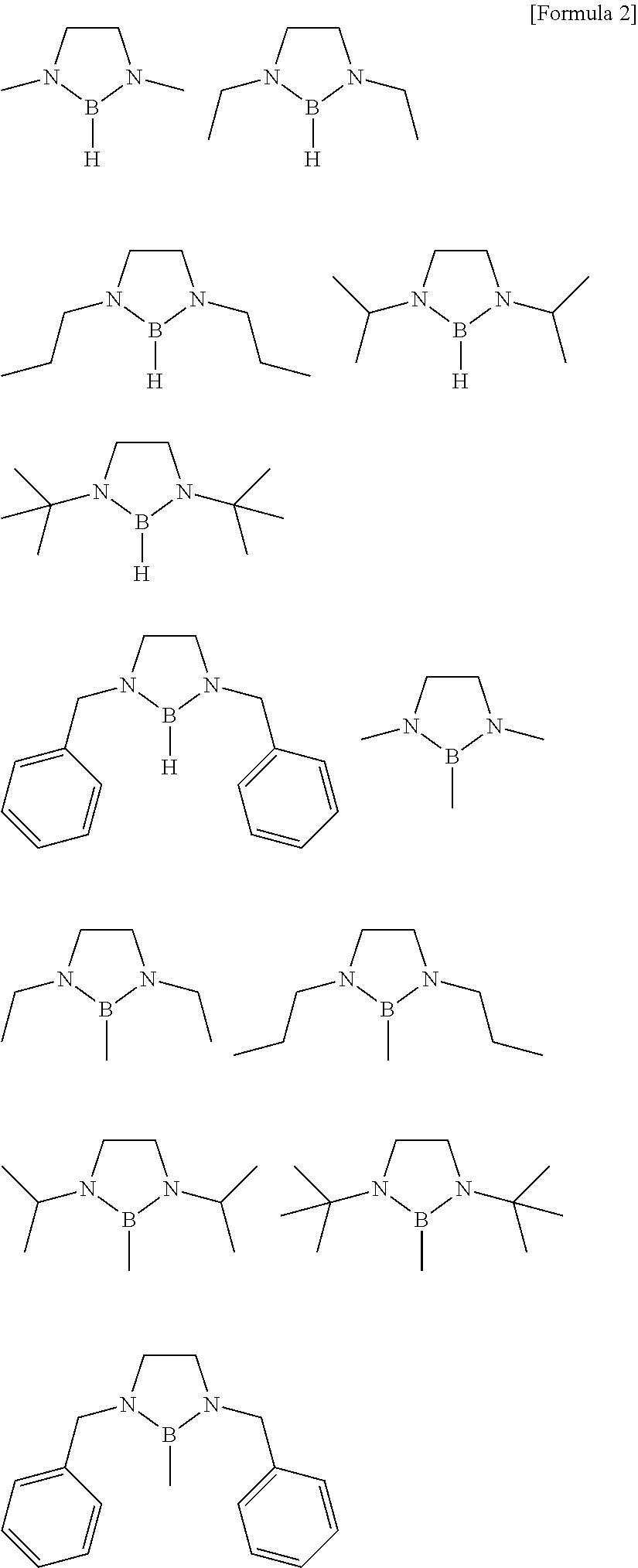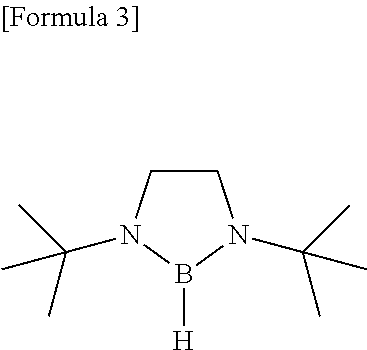Diffusing agent composition and method of manufacturing semiconductor substrate
Active Publication Date: 2019-02-07
TOKYO OHKA KOGYO CO LTD
View PDF1 Cites 2 Cited by
- Summary
- Abstract
- Description
- Claims
- Application Information
AI Technical Summary
Benefits of technology
The patent text describes a new invention that uses certain boron compounds to achieve certain effects. The boron compounds can be selected from a group of formulas (a1) to (a4) below:
(a1) R3 is a hydrogen atom, a hydrocarbon group with 1 to 10 carbon atoms, or a hydrocarbon group with 1 to 10 carbon atoms and a divalent aliphatic hydrocarbon group with 1 to 10 carbon atoms.
(a2) R4 is a hydrocarbon group with 1 to 10 carbon atoms, a cycloalkyl group with 6 to 10 carbon atoms, or a cycloalkyl group with 7 to 10 carbon atoms.
(a3) R5 is a hydrogen atom, a hydrocarbon group with 1 to 10 carbon atoms, or a hydrocarbon group with 1 to 10 carbon atoms and a divalent aliphatic hydrocarbon group with 1 to 10 carbon atoms.
The patent text also mentions that certain types of hydrocarbon groups are preferred, such as methyl, ethyl, n-propyl, isopropyl, n-butyl, isobutyl, sec-butyl, tert-butyl, phenyl, and benzyl groups.
The invention uses these boron compounds to achieve various effects, such as improving the efficiency of a heat exchanger, reducing the size of a heat exchanger, and increasing the power output of a heat exchanger. These effects can be achieved by using the boron compounds in the invention in various ways, such as by improving the performance of the heat exchanger, reducing the size of the heat exchanger, or increasing the power output of the heat exchanger.
Problems solved by technology
However, in the ion implantation method as disclosed in Patent Document 1, when a light ion such as B (boron) is implanted into the semiconductor substrate, in a region near the surface of the substrate, a point defect or a point defect cluster is easily formed.
For example, when an impurity diffusion component is diffused by the ion implantation method into a semiconductor substrate, and thus an element such as a CMOS image sensor is formed, the occurrence of such a defect directly leads to a reduction in the performance of the element.
For example, when a semiconductor substrate includes, on its surface, a three-dimensional structure on a nanometer scale such as a three-dimensional structure for forming a multi-gate element called a Fin-FET which includes a plurality of source fins, a plurality of drain fins and gates orthogonal to those fins, in the ion implantation method, it is difficult to uniformly implant ions into the side surface and the upper surface of the fins and gates and the entire inner surface of a concave portion surrounded by the fins and the gates.
When an impurity diffusion component is diffused by the ion implantation method into a semiconductor substrate having a three-dimensional structure on a nanometer scale, even if the uniform implantation of ions is achieved, there are failures which will be described below.
For example, when a semiconductor substrate which includes a three-dimensional pattern having small fins is used so as to form a logic LSI device or the like, the crystal of a substrate material such as silicon is easily damaged by ion plantation.
It is considered that the damaged crystal causes a failure such as a variation in the property of the device or the production of a standby leak current.
When the CVD method disclosed in Patent Document 2 is applied, by an overhang phenomenon, it is difficult to coat the entire inner surface of a concave portion surrounded by fins and gates with an oxide film whose film thickness is uniform and which includes an impurity diffusion component, and an opening portion is disadvantageously blocked by an oxide deposited on the opening portion in the concave portion surrounded by the fins and the gates.
As described above, in the ion implantation method and the CVD method, depending on the shape of the surface of the semiconductor substrate, it is difficult to satisfactorily and uniformly diffuse the impurity diffusion component into the semiconductor substrate.
Method used
the structure of the environmentally friendly knitted fabric provided by the present invention; figure 2 Flow chart of the yarn wrapping machine for environmentally friendly knitted fabrics and storage devices; image 3 Is the parameter map of the yarn covering machine
View moreImage
Smart Image Click on the blue labels to locate them in the text.
Smart ImageViewing Examples
Examples
Experimental program
Comparison scheme
Effect test
examples
[0075]Although the present invention will be more specifically described below using examples, the present invention is not limited to the examples below.
the structure of the environmentally friendly knitted fabric provided by the present invention; figure 2 Flow chart of the yarn wrapping machine for environmentally friendly knitted fabrics and storage devices; image 3 Is the parameter map of the yarn covering machine
Login to View More PUM
| Property | Measurement | Unit |
|---|---|---|
| Thickness | aaaaa | aaaaa |
| Thickness | aaaaa | aaaaa |
| Fraction | aaaaa | aaaaa |
Login to View More
Abstract
A diffusing agent composition that can efficiently form a thin film in which an impurity diffusion component can be diffused into a semiconductor substrate at a higher concentration than a conventional one and a method of manufacturing a semiconductor substrate using the diffusing agent composition. The diffusing agent composition includes an impurity diffusion component and a silane coupling agent the silane coupling agent including a group which generates a silanol group by hydrolysis and alkyl groups and at least one of the alkyl groups includes, in a chain and / or at an end, at least one amino group selected from a primary amino group, a secondary amino group and a tertiary amino group.
Description
[0001]This application claims priority to Japanese Patent Application No. 2017-151973, filed Aug. 4, 2017, the entire content of which is incorporated herein by reference.BACKGROUND OF THE INVENTIONField of the Invention[0002]The present invention relates to a diffusing agent composition which is used for diffusing an impurity diffusion component into a semiconductor substrate and a method of manufacturing a semiconductor substrate using the diffusing agent composition.Related Art[0003]Semiconductor substrates used in semiconductor elements such as transistors, diodes and solar batteries are manufactured by diffusing impurity diffusion components such as phosphorus and boron into the semiconductor substrates. With respect to the semiconductor substrates described above, when a semiconductor substrate for a multi-gate element such as a Fin-FET or a nanowire FET is manufactured, for example, an impurity may be diffused into a semiconductor substrate which includes, on its surface, a t...
Claims
the structure of the environmentally friendly knitted fabric provided by the present invention; figure 2 Flow chart of the yarn wrapping machine for environmentally friendly knitted fabrics and storage devices; image 3 Is the parameter map of the yarn covering machine
Login to View More Application Information
Patent Timeline
 Login to View More
Login to View More IPC IPC(8): H01L21/225H01L21/02C09D5/24C09D7/63
CPCH01L21/2256H01L21/02129C09D5/24C09D7/63H01L21/02282H01L21/2225H01L21/2254C09K3/00C09D7/40C09D4/00H01L21/22H01L21/02052H01L21/02307
Inventor TAKAHASHI, YUKUBO, KEISUKE
Owner TOKYO OHKA KOGYO CO LTD
Features
- R&D
- Intellectual Property
- Life Sciences
- Materials
- Tech Scout
Why Patsnap Eureka
- Unparalleled Data Quality
- Higher Quality Content
- 60% Fewer Hallucinations
Social media
Patsnap Eureka Blog
Learn More Browse by: Latest US Patents, China's latest patents, Technical Efficacy Thesaurus, Application Domain, Technology Topic, Popular Technical Reports.
© 2025 PatSnap. All rights reserved.Legal|Privacy policy|Modern Slavery Act Transparency Statement|Sitemap|About US| Contact US: help@patsnap.com



